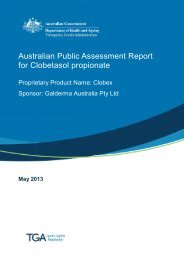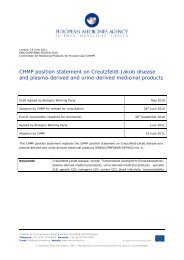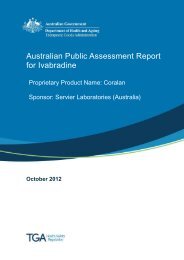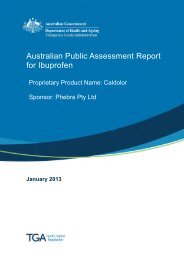AusPAR: Cabazitaxel - Therapeutic Goods Administration
AusPAR: Cabazitaxel - Therapeutic Goods Administration
AusPAR: Cabazitaxel - Therapeutic Goods Administration
You also want an ePaper? Increase the reach of your titles
YUMPU automatically turns print PDFs into web optimized ePapers that Google loves.
Participant flow<br />
<strong>AusPAR</strong> Jevtana <strong>Cabazitaxel</strong> Sanofi-Aventis Australia Pty Ltd PM-2010-02565-3-4<br />
Final 9 February 2012<br />
<strong>Therapeutic</strong> <strong>Goods</strong> <strong>Administration</strong><br />
A total of 755 patients were centrally randomized, with 377 patients in arm A<br />
(mitoxantrone [MTX] + prednisone [pred]) and 378 patients in arm B (cabazitaxel [CBZ] +<br />
pred). The median number of cycles was 4 in arm A and 6 in arm B. In all 13.5% of patients<br />
in arm A and 29.4% in arm B completed all 10 treatment cycles. The most common reason<br />
for treatment discontinuation was disease progression, 70.8% of patients in arm A and<br />
47.6% in arm B. The second most common reason for treatment discontinuation was<br />
completed study treatment (without progression), 12.2% of patients in arm A and 27.8%<br />
in arm B. Six patients in arm A and 7 patients in arm B were randomized but not treated.<br />
Of the 7 patients who discontinued treatment for 'other reasons' in arm A, 4 had protocol<br />
violations, 2 had clinical progression and 1 was discontinued by the investigator. Of the 10<br />
patients who discontinued treatment for 'other reasons' in arm B, 2 refused treatment, 2<br />
had protocol violations, 2 had adverse events (abnormal liver function tests (LFTs), fever<br />
with increased white blood cell (WBC) count, 1 had disease progression that was not<br />
confirmed by standard means.<br />
Baseline data<br />
The demographic characteristics were well balanced between the two arms. Almost half<br />
the patients in the two arms had non-measurable disease. As per protocol over 99% of the<br />
patients had had prior hormone therapy and over 80% (MTX+pred: 87.3%; CBZ+pred:<br />
87.8%) had received docetaxel as their first chemotherapy. The majority of patients in<br />
each group were randomized within 6 months of docetaxel treatment. Overall, 75.6% of<br />
patients in arm A and 72.2% of patients in arm B had relapsed within 3 months of<br />
completing that docetaxel treatment. The majority of patients had 1 or 2 metastatic sites.<br />
At baseline, anaemia was the most common haematological abnormality. Because of the<br />
high incidence of bone metastases in this population, abnormal levels of alkaline<br />
phosphatase (ALP) were common.<br />
Concomitant medications included corticosteroids, antihistamines and H2 antagonists.<br />
Results for the primary efficacy outcome<br />
The median survival was 12.7 months in arm A and 15.1 months in arm B. The difference<br />
was statistically significant (Table 5, Figure 2). The hazard ratio (HR) was 0.70 (95% CI:<br />
0.59 - 0.83) in favour of cabazitaxel.<br />
Table 5: Descriptive analysis of overall survival - ITT population<br />
Page 32 of 75
















